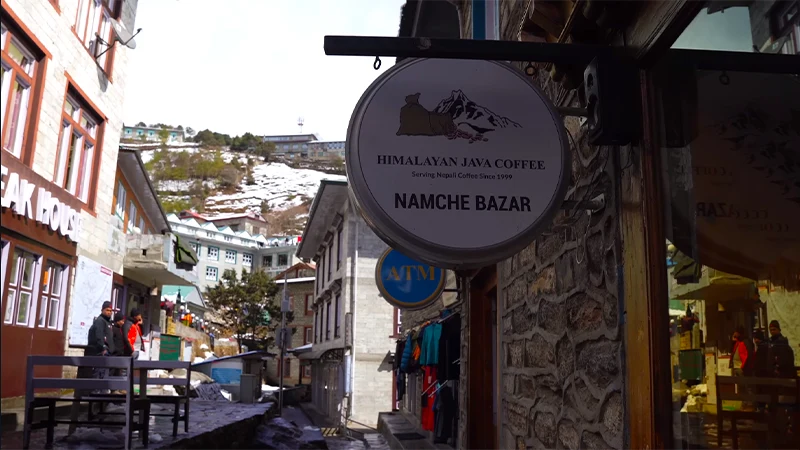The Everest Base Camp Trek is one of the world’s most iconic and challenging treks. Its stunning views of the Himalayas, unique culture, and rugged terrain attract adventurers from around the globe. While the trek is known for its difficult terrain and breathtaking views, food and drinks in Everest Base Camp Trek also play a crucial role in ensuring its success and enjoyment.
When planning this hike, one of the most important things to consider is what kinds of food and drinks you can get along the way. You need to eat and drink the right things to stay healthy and full of energy on your trip.
EBC Trek is challenging and burns many calories after a long day’s walk in rough terrain. That is why you must maintain your energy level through the trail, which is challenging.
So, how do you maintain your diet while walking?
What types of food are available during the trek to Everest Base Camp?
Always remember that; you don’t get overloaded with unhealthy food while still having a lot of walking left. So, make sure that your tummy is filled only with healthy foods.
This comprehensive guide will explore the different food and drink options on the Everest Base Camp trek. This blog also provides tips to help you make the most of your fantastic experience. Read on to find out what Everest Base Camp offers, whether you’re a foodie who wants to try something new or a hiker who needs food to keep going.
What food is available in teahouses?
Along the Everest Base Camp Trek route, most teahouses serve various food, from traditional Nepalese dishes to those from other countries. Most tea houses during the EBC trek are run by the locals. So, you have an excellent opportunity to get an insight into local and fresh foods along the way.
The meals are served three times a day. The food will benefit from the teahouse menu, and all the food menus are similar along the whole trek. But some luxurious hotels provide a surprising number of options.
Here are some everyday food items that you might find on the menu at Everest Base Camp:
Dal Bhat: This traditional Nepali dish consists of steamed rice, lentil soup, and vegetables.
Momos: These are small, steamed, or fried dumplings filled with meat or vegetables and often served with a spicy sauce.
Thukpa: This is a hearty noodle soup famous in the Himalayan region, typically made with vegetables or meat.
Fried rice or noodles: They are common in most teahouses and restaurants along the trek. They are usually served with meat or vegetables.
Pizza: Some teahouses may offer pizza made with a variety of toppings.
Pancakes: Often served as a breakfast item, pancakes can be sweet or savory, with options such as banana, chocolate, or cheese.
Soups: Teahouses offer a variety of soups, such as tomato, vegetable, or mushroom.
Snacks: Teahouses offer popcorn, peanuts, biscuits, and chocolate bars.
Drinks: Teahouses serve various beverages, including tea, coffee, hot chocolate, and soft drinks. Some teahouses may also serve alcohol, but it is best to drink in moderation and be aware of how drinking alcohol affects you when you are at a high altitude.
Remember that the availability of specific food items may vary depending on the teahouse and season, so it’s a good idea to ask your guide or teahouse owner for recommendations.
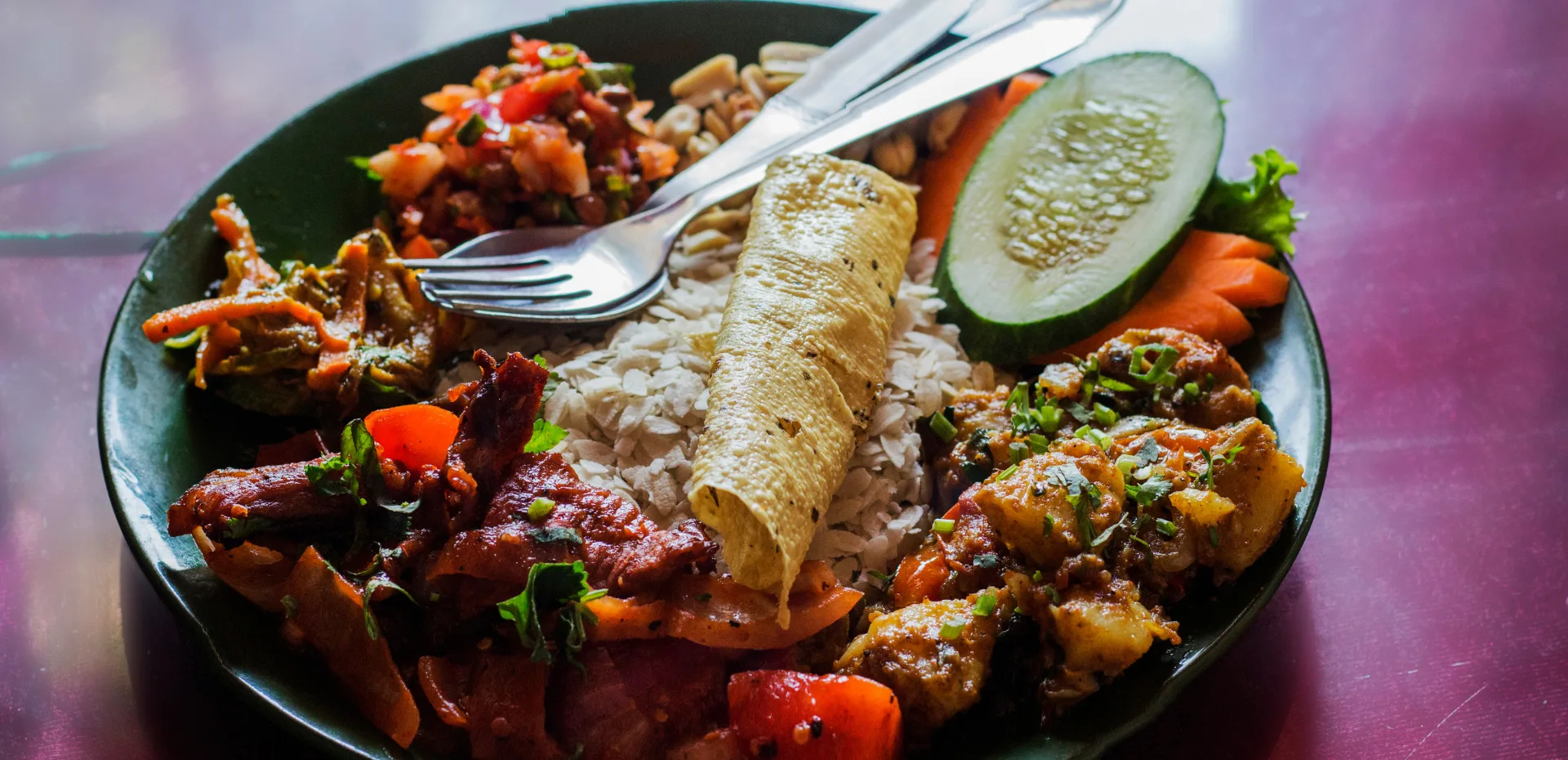
How much is food on the Everest Base Camp Trek?
The cost of food on the Everest Base Camp Trek can vary depending on a number of factors, such as the type of food, the location, and the season. Here are some general estimates of food costs:
Teahouse Meals: If you are staying in teahouses along the trek, you can expect to pay between $5 and $8 for a basic meal. This is usually a dish like dal bhat, which is rice, lentils, and vegetables, or noodles or momos, which are dumplings. Tea or coffee may be included or cost an additional $1–3.
Snacks: You can also expect to pay around $2–5 for snacks such as chocolate, energy bars, or biscuits.
Water: You should budget around $2–3 per liter for bottled water. It is important to stay hydrated during the trek, so you may want to budget for at least 2-3 liters per day.
Special Meals: If you opt for more elaborate meals, such as pizza, spaghetti, or steak, expect to pay more. These meals may cost $10 to $15 or more.
Overall, you can expect to pay between $16 and $25 per day for food and water on the Everest Base Camp Trek. However, keep in mind that prices may be higher during peak trekking season and in more remote areas.
Typical Meals on the Everest Base Camp Trek
Meals are essential during the Everest Base Camp Trek for several reasons. First, the trek is strenuous on your body, so you’ll need to eat enough calories to keep your energy up and keep your body working right. At higher altitudes, trekking takes more energy than at lower altitudes, so it’s important to eat enough to avoid getting tired or getting altitude sickness.
Below, we have provided you with the food menu, including breakfast, lunch, and dinner.
Breakfast options during the Everest Base Camp Trek
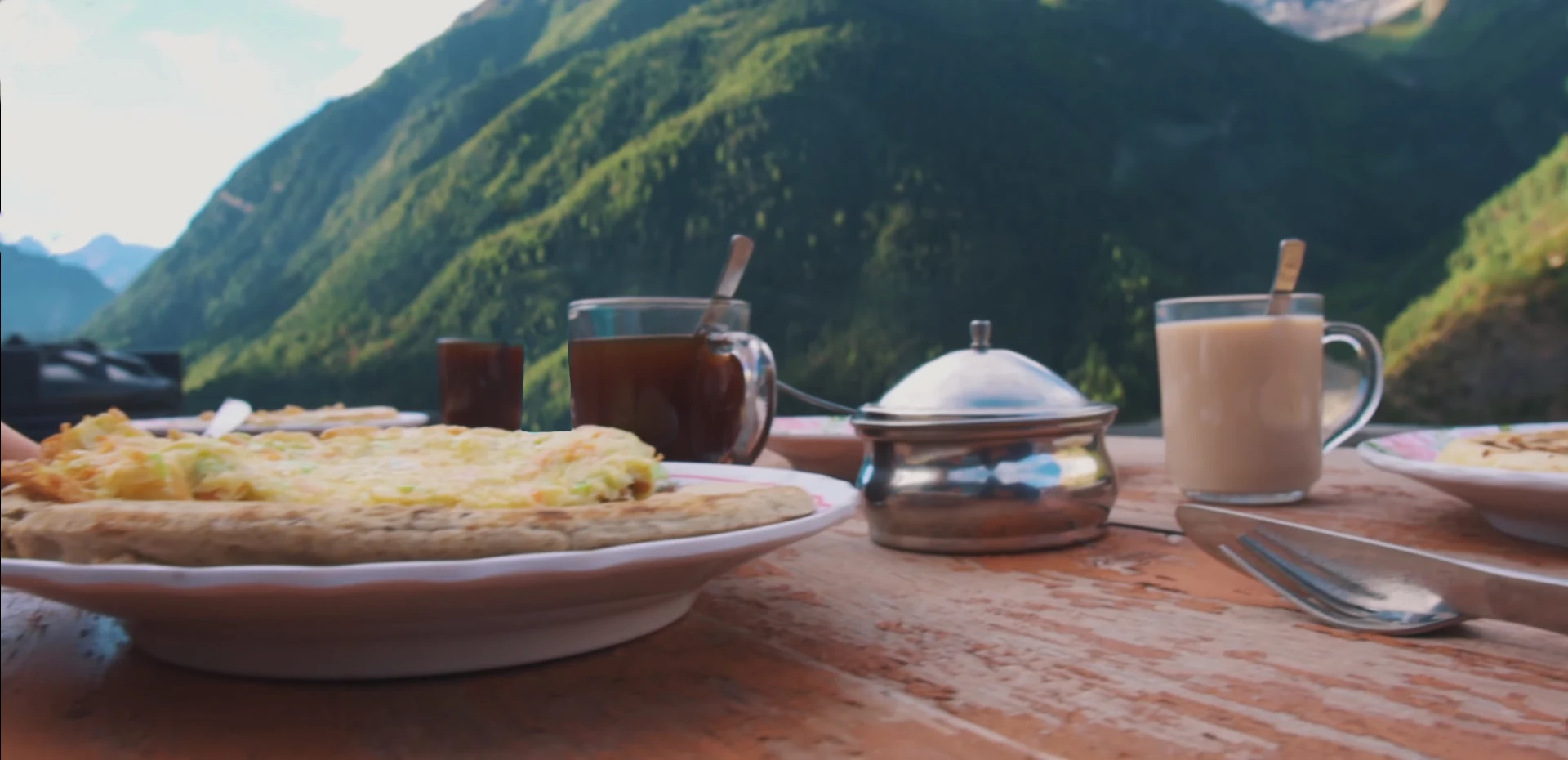
Breakfast is an important meal during the Everest Base Camp Trek, as it provides the necessary energy and nutrients to start your day of trekking. Before trekking for the day, you should eat a hearty breakfast. This will help keep your energy up and keep you from getting tired.
Fresh Baked Bread
- Toast bread (jam, peanut or honey)
- Tibetan bread
- French toast
- Cheese toast
- Toast with baked beans
- Vegetable cheese sandwich
- Tuna veg. cheese sandwich
- Ham cheese sandwich
- Honey toast
- Jam toast
- Toast bread with egg and cheese
- Plain toast
- Tomato cheese sandwich
Eggs
- Boiled eggs
- Plain omelets
- Scrambled eggs
- Fried eggs
- Veg omelets
- Tomato omelet
- Cheese omelets
- Mix omelet
Hash Brown/ Mash Potato
- Hash brown (Veg, Cheese)
- Hash brown (Egg & Cheese)
- Mixed Hash brown
- Mash Potatoes Veg Cheese
- Mash Potatoes Egg-Cheese
- Mix Mash Potatoes
Pancakes & Chapati
- Pancake with jam, peanut or honey
- Apple pancake
- Egg pancake
- Chocolate pancake
- Lemon pancake
- Cinnamon sugar pancake
- Chapati plain
- Chapati egg
- Chapati with honey, peanut butter, egg and baked beans
Porridge
- Oat porridge
- Cinnamon porridge
- Tsampa porridge
- Apple porridge
- Honey porridge
- Porridge with cinnamon and resins
- Muesli with hot milk
- Cornflakes with hot milk
- Rice pudding
- Chocolate pudding
Lunch options during Everest Base Camp Trek
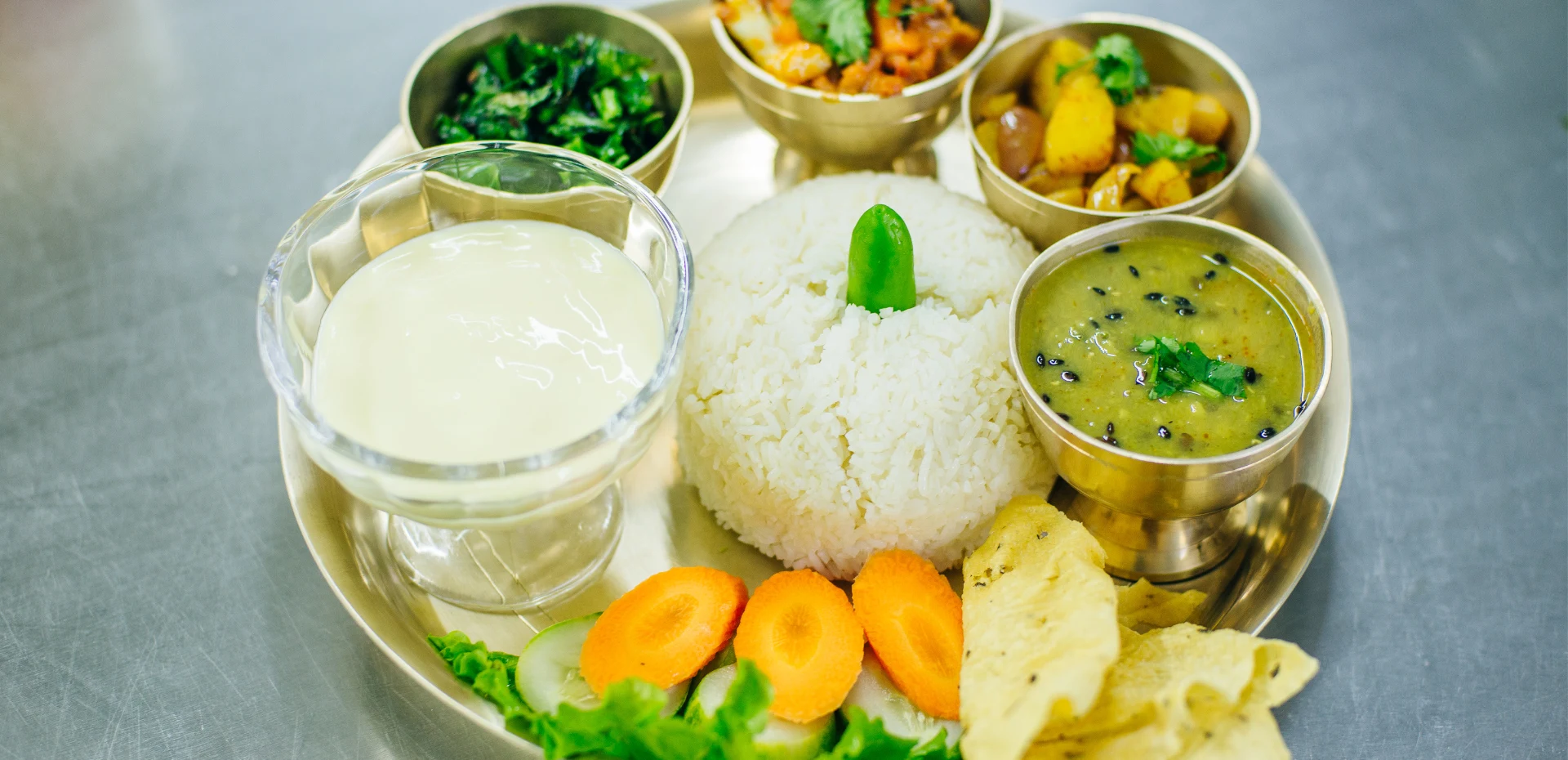
During the trek to Everest Base Camp, lunch is usually made of foods high in carbs and whole grains. It is generally served in the afternoon, typically around 12 p.m. to 1:00 p.m.
Traditional Nepalese foods like dal, rice, curry, and pickles are often on the menu at these tea houses. In all of these options, there are various varieties to choose from.
Rice Dish
- Plain rice
- Veg. rice dish
- Chicken rice dish
- Egg curry
- Fried rice (veg/ cheese/ egg/ chicken)
- Tuna fried rice
- Mixed fried rice
Noodles
- Veg fried noodles
- Veg cheese fried noodles
- Egg fried noodles
- Fried noodles with cheese
- Mixed fried noodles
- Thukpa
Momos (Steam/ Kothey/ Fried)
- Veg momo
- Buff momo
- Chicken momo
- Cheese momo
- Potato cheese momo
- Tuna momo
- Mixed momo
Pasta and Macaronis
- Veg fried pasta
- Cheese fried pasta
- Pasta with cheese and tomato sauce
- Plain macaroni
- Macaroni tomato sauce
- Macaroni tomato sauce with cheese
- Macaroni tomato sauce with tuna
- Macaroni with vegetables, cheese, and egg
- Veg-fried macaroni
- Veg-fried macaroni with cheese & eggs
- Veg-fried macaroni with tune
- Veg-fried macaroni with cheese and tuna
Spring Rolls
- Vegetable spring roll
- Egg spring roll
- Veg egg roll
- Veg cheese roll
- Chicken spring roll
- Potato spring roll
- Mix roll
Pizzas
- Pizza Margherita (tomato & cheese)
- Pizza vegetable (tomato, veg & cheese)
- Pizza tuna (tomato, tuna & cheese)
- Pizza mushroom (tomato, mushroom & cheese)
- Pizza barbecued chickens (tomato, B.B chicken & cheese)
Spaghetti
- Boiled spaghetti
- Spaghetti cheese and tomato sauce
- Spaghetti tomato sauce
- Spaghetti tomato sauce with tuna
- Spaghetti with tuna, cheese, and tomato sauce
- Veg-fried Spaghetti
- Veg-fried Spaghetti with cheese & egg
- Veg-fried Spaghetti with tuna
- Veg-fried Spaghetti with cheese and tuna
- Boiled spaghetti white sauce
- Spaghetti bolognese
Sandwich / Burger (may be served with french fries)
- Veg sandwich
- Omelet Sandwich
- Grilled cheese tomato sandwich
- Grilled tomato egg sandwich
- Grilled tuna and tomato sandwich
- Ham sandwich
- Ham and cheese sandwich
- Tuna tomato & cheese sandwich
- Chicken burger
- Cheese burger
The above food menu is only a sample; you might get more or less depending on the menu of the tea house. Also, the teahouse menu will decrease as you go to a higher altitude.
Dinner options during the Everest Base Camp Trek
Dinner will be provided in the lodge where you will spend the night, usually between 7:30 p.m. and 8:00 p.m. The meal options will be consistent with the lodge’s menu and comparable to lunch.
You may select the Nepali Dal Bhat, a traditional dish, or choose from the Western-style items listed on the menu.
Vegetarian or vegan options in Everest Base Camp Trek
If you are vegetarian or vegan, make sure to check the menu before booking the teahouse during the trek. As the number of hotels, restaurants, and teahouses on the Everest trails grows, some will offer vegetarian and vegan options.
It’s important to note that dairy products such as cheese and yogurt are also commonly consumed in Nepal, so you may have more limited options. Bring snacks or supplements for protein and other nutrients during the trek.
Vegans often eat mashed potatoes, oats, porridge, pancakes, chapati, toast, and fruit smoothies made with seasonal fruits for breakfast. Lunch and dinner have many options, like Dal Bhat with plain white rice, lentil soup, vegetables, and pickles. Some other vegan options for lunch and dinner include Veggie burgers, Veg momos, Veggie fried rice, Lentil soup and chapati, Veggie thukpa, noodle soups, veg pasta with tomato sauce, etc.
If you want something new and local, try Sherpa foods in the EBC trek, like Tsampa or Tibetan bread for breakfast and Sherpa stew, Veg thukpa, potato pancakes, or Tmomo and Rildhuk (soup with potato lumps).
Tips: When making a reservation, always request that the hotel staff exclude vegans’ dairy and meat so they can cook it for you. It can be beneficial to bring snacks or supplements to ensure you obtain enough protein and nutrients during the trek.
Popular snack options on the trek
On the way to Everest Base Camp, there are a lot of popular places to stop for snacks. Here are some examples:
- Chocolate bars: Chocolate bars are a popular snack option on the trek as they provide a quick energy boost and are easy to carry in your backpack. Some popular brands available in Nepal include Snickers, Mars, and KitKat.
- Trail mix: It is a mix of nuts, seeds, and dried fruits. It is a healthy and nutritious snack option that is perfect for trekking. You can buy pre-made trail mix packets at tea houses or make your own at home.
- Nuts: almonds, cashews, peanuts, etc., are a great source of protein and healthy fats, which provide sustained energy to the body. The combination of protein and healthy fats in nuts provides a slow and sustained release of energy, which can help keep you feeling full and energized for longer periods of time.
- Biscuits and cookies: There are many tea houses along the trek that sell biscuits and cookies. They are an easy and convenient snack option that can be enjoyed with a cup of tea or coffee.
- Fruit: Fresh fruit such as apples, bananas, and oranges are available at some tea houses along the trek. They are a healthy and refreshing snack option that provides essential nutrients and vitamins.
It’s important to note that these snack options may vary in availability depending on the tea house or lodge you stay at. It is always a good idea to carry some of your own snacks in case your preferred options are not available.
Drinks on the Everest Base Camp Trek
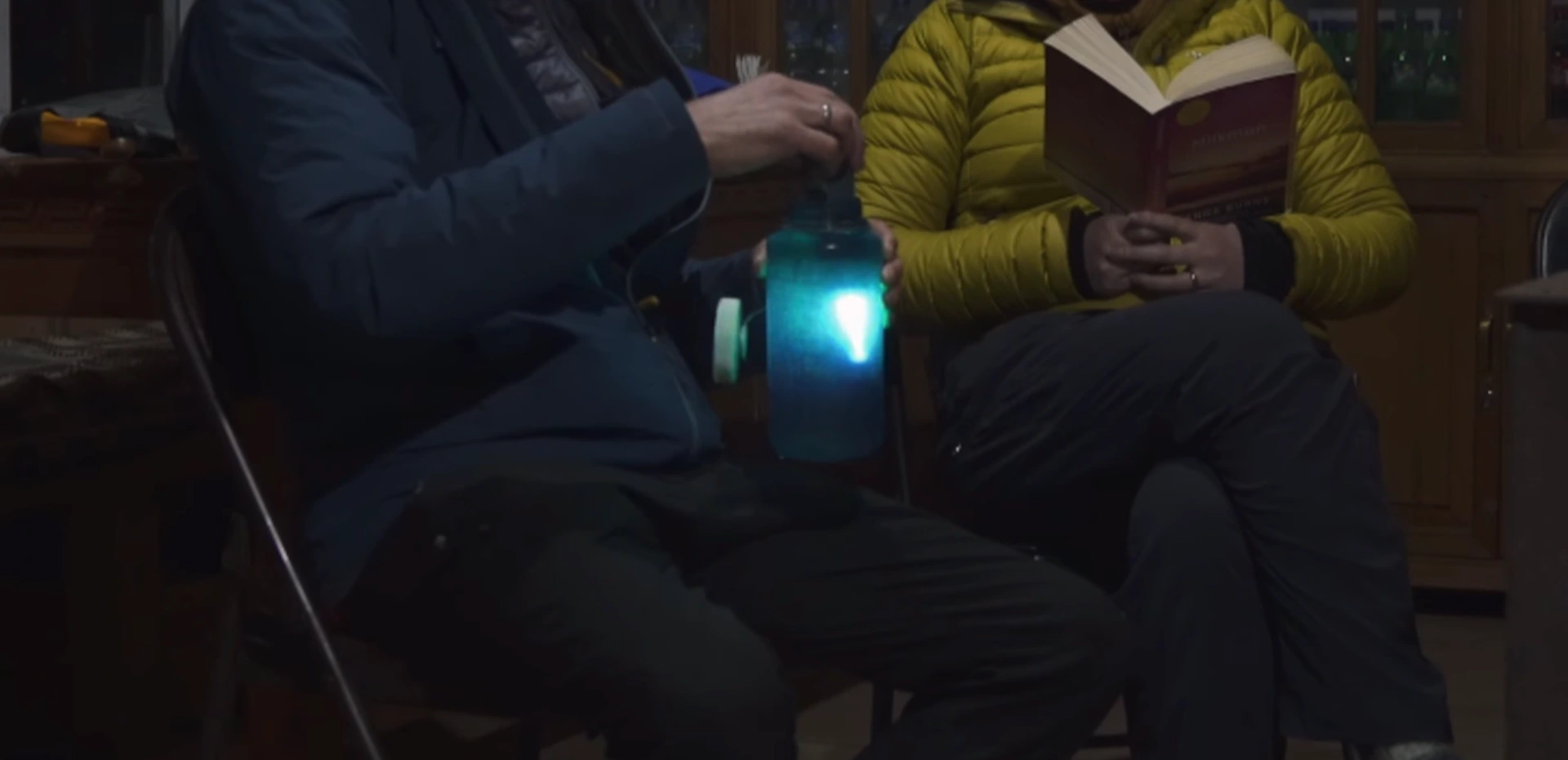
For a safe and successful trip to Everest Base Camp, it is important to drink enough water. During the Everest Base Camp Trek, drinks keep hikers hydrated and give them energy. Adequate hydration is essential for preventing altitude sickness and maintaining physical performance.
While water is the most important drink, tea also has benefits on the trek. Tea, especially ginger or lemon tea, can help with altitude sickness symptoms like nausea and headaches.
Water sources and purification methods
When trekking to Everest Base Camp, it is crucial to stay hydrated to avoid altitude sickness and other health issues. However, the quality of water sources in the region may only sometimes be safe for consumption. In this section, we’ll talk about the different places you can get water and how you can clean it to ensure it’s safe to drink.
Water sources on the trek include streams, rivers, and tap water at teahouses. However, it is important to note that water quality may be unsafe for consumption due to the risk of waterborne diseases. Therefore, it is recommended to purify water before drinking it.
Purification Methods
There are different ways to clean water while hiking to Everest Base Camp, each with pros and cons. In this section, we will look at each purification method, its pros and cons, and how it works.
Boiling Water
Boiling water is a simple and effective method of water purification. The process kills most bacteria, viruses, and parasites, making drinking water safe. Water should be heated to a rolling boil for at least one minute (three minutes at high altitude). The heat can be provided by a camping stove or by an open fire.
Advantages:
Effective against a wide range of waterborne pathogens
No chemical taste or odor
It does not require any special equipment (except for a heat source)
Disadvantages:
It can be time-consuming and requires a heat source and fuel
Water must be cooled before drinking
It does not remove sediment or chemicals
Water Purification Tablets
Water purification tablets are lightweight and easy to use. They contain chemicals, such as chlorine or iodine, that kill bacteria and viruses in the water. Add the tablet(s) to the water and wait for the specified time before drinking.
Advantages
- Lightweight and easy to carry
- Effective against bacteria, viruses, and some parasites
- No taste or odor
Disadvantages
- It may leave an aftertaste or discoloration in the water
- It may take up to 30 minutes to become effective
- Not effective against some parasites or chemicals
Water Filters and Purifiers
Water filters and purifiers work well to eliminate bacteria, viruses, parasites, sediment, and chemicals in the water. Filters use a physical barrier to keep out contaminants, while purifiers kill pathogens with chemicals or UV light. Some models are designed to be used with a pump, while others are gravity-fed.
Advantages
- Effective at removing a wide range of contaminants
- It can be lightweight and easy to use
- Some models do not require batteries or chemicals
Disadvantages
- It can be heavy and take up space in a backpack
- It may require maintenance or replacement parts
- Not effective against all types of parasites
SteriPENs
SteriPENs use UV light to kill bacteria, viruses, and parasites in the water. The device is inserted into the water and turned on for a specified amount of time. The light kills the pathogens and makes the water safe to drink.
Advantages
- Lightweight and easy to use
- Effective against a wide range of waterborne pathogens
- No aftertaste or chemicals were added to the water
Disadvantages
- Requires batteries or charging
- Can be expensive
- It may not be effective against some parasites or sediment
In conclusion, several methods exist for purifying water while trekking to Everest Base Camp. The method chosen will depend on personal preferences, the availability of equipment, and the specific water sources encountered on the trail.
Tea and coffee on Everest Base Camp Trek
Tea and coffee are popular beverage options on the Everest Base Camp trek. Here are some details about these options:
Tea
Tea is a staple beverage in Nepali culture and is available throughout the trek.
The most common type of tea served on the trek is masala tea, or chai, which is a spiced tea made with a blend of black tea, milk, sugar, and spices like cinnamon, ginger, and cardamom.
Other types of tea available on the trek include lemon tea, mint tea, and green tea.
Tea is usually served in small tea houses or lodges along the trekking route.
Coffee
Coffee is also available on the Everest Base Camp trek, but it may not be as widely available as tea. The coffee served on the trek is usually instant coffee or brewed coffee made with locally grown coffee beans. Some tea houses or lodges may have a variety of coffee drinks, such as espresso, cappuccino, or latte. Coffee is usually more expensive than tea on the trek.
It’s important to remember that even though tea and coffee are popular drinks on the trek, you should limit how much of them you drink to avoid getting dehydrated at high altitudes. It’s also a good idea to bring your own instant coffee or tea bags if you have a preference for a specific type or brand. Additionally, be prepared to pay more for hot drinks as you go higher on the trek.
Alcoholic beverages on the trek
Due to the trek’s high altitude and physical demands, drinking alcohol on the Everest Base Camp Trek can be very dangerous. It is recommended to limit or avoid alcohol consumption altogether.
Alcohol can exacerbate the symptoms of altitude sickness, including headaches, nausea, and fatigue. Alcohol is a diuretic and can increase dehydration, which is already a concern at high altitudes.
If you do decide to drink alcohol on the trek, you should do so in moderation and only after you have gotten used to the high altitude. Be sure to drink plenty of water to stay hydrated and avoid drinking alcohol in high quantities or alone.
Other popular drink options on the EBC trek
You will find plenty of other drink options on the trek. Below, we provide you with the menu of other drinks along the Everest Base Camp Trek.
Hot Drinks
- Black Tea
- Milk Tea
- Lemon Tea
- Hot Lemon
- Milk Coffee
- Black Coffee
- Hot orange
- Hot Water
- Mint Tea
- Ginger Tea
- Hot Mango
- Fresh Filter Coffee
- Hot Chocolate
- Peppermint Tea
Soups
- Rara Noodle Soup
- Vegetable Soup
- Chicken Soup
- Tomato Soup
- Potato Soup
- Lentil Soup
- Sherpa Stew
- Local Noodles Soup
- Tomato Garlic Soup
- Garlic Noodle Soup
What should I eat before the EBC Trek?
Before trekking, it’s important to fuel your body with the proper nutrients to provide energy and endurance. Here are some foods to consider eating before trekking:
Carbohydrates: Foods rich in carbohydrates, such as bread, pasta, rice, and potatoes, can provide a good energy source for your body during the trek.
Protein: Foods rich in protein, such as chicken, fish, eggs, nuts, and beans, can help to repair and build muscle tissue, which is important for endurance.
Fruits and Vegetables: Eating fruits and vegetables before the trek can provide your body with the necessary vitamins and minerals to support your immune system and overall health.
Hydrating fluids: Drinking plenty of water and other hydrating liquids, such as coconut water or sports drinks, can help you stay hydrated and energized during the trek.
What not to eat during the EBC Trek?
When trekking, it’s important to be mindful of what you eat to avoid digestive problems and other health issues. Here are some things you should try to avoid:
- Raw or undercooked meat can lead to foodborne illnesses, such as salmonella or E. coli, which can cause vomiting, diarrhea, and dehydration.
- Don’t drink tap water on the trek because it might have harmful bacteria or parasites in it. Instead, drink bottled water or water purification tablets or a water filter.
- Unwashed fruits and vegetables can expose you to harmful bacteria and pesticides. It’s best to wash them thoroughly or peel them before eating.
- Fried or greasy foods can be heavy and hard to digest, making your stomach hurt and making you feel slow while hiking.
- Dairy products are a good source of protein, but they can be difficult to digest at high altitudes, leading to bloating and stomach discomfort. Consider limiting your intake or opting for non-dairy alternatives.
- Spicy and heavily seasoned foods can irritate your stomach and cause heartburn or indigestion, especially if you’re not used to them. It’s best to stick to milder foods while trekking.
What to eat after the EBC trek?
After completing a challenging trek like the Everest Base Camp Trek, it’s important to refuel your body with nutritious foods. Your body has likely burned many calories during the trek, so it’s important to eat a balanced diet that provides enough energy and nutrients to help your body recover.
Final Thoughts
Finally, food and drinks are essential to the Everest Base Camp trek. Considering hygiene and safety when choosing where to eat and what to drink is also very important.
When thinking about the challenges of being at a high altitude, it is important to put nutritious food, water, and comfort at the top of your list. Packing the right snacks, staying hydrated, and trying local dishes can fuel your body and elevate your taste buds.
Eating and drinking enough is essential, but remember to enjoy the local food and the unique dining experience of the Everest Base Camp Trek. So, savor the flavors of the Himalayas on your next adventure to Everest Base Camp!
In conclusion, the food and drinks you bring on the Everest Base Camp trek are important if you want to stay healthy, stay energized, and enjoy the trek. By being mindful of what we consume and supporting local food, we can have an incredible experience while trekking to the highest peak in the world.


